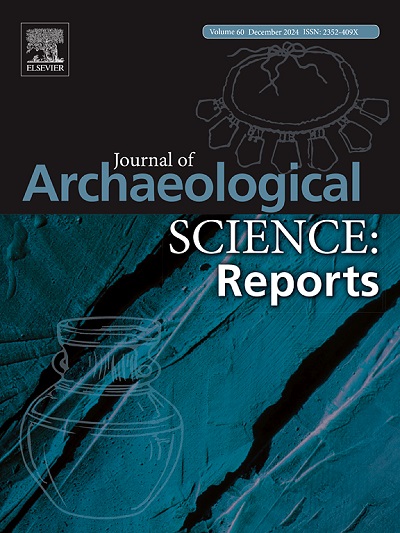案例研究:根据对波兰科济格沃伊(2470 ± 35 BP)卢萨特文化人类遗骸进行的牙科和同位素分析评估饮食行为
IF 1.5
2区 历史学
0 ARCHAEOLOGY
引用次数: 0
摘要
当代生物考古学研究的对象既有大型人群,也有小型人群,通常涉及对成套骸骨的分析。后者尤其适用于在 Koziegłowy 遗址发现的骸骨,这些骸骨可以追溯到卢萨特文化时期(当时火葬是主要的墓葬形式)。因此,保存这一时期的骸骨具有极其重要的意义。卢萨西亚文化的主要人类群体被认为是以畜牧业(主要是牛、羊、猪和马)为主的定居经济。从卢萨卡文化人群的饮食中应该可以发现这种经济的事实。本研究的目的是根据龋齿的频率和对稳定氮和碳同位素(分别为 δ15N 和 δ13C)的评估来重建饮食行为。对 9 个成年人(5 个女性、2 个男性和 2 个性别不明的个体)的 63 颗恒牙残骸进行了分析。采用了宏观、X 射线和光诱导荧光技术方法。使用贝叶斯混合模型 "利用同位素传递信号的食物重建"(FRUITS)进行饮食重建。结果显示,龋齿并不常见(11%,7/63 颗牙齿)。这可能是因为饮食中含有各种食物来源和少量碳水化合物(龋齿的主要原因)。同位素分析似乎证实了这一假设。在动物蛋白摄入量相对较低(动物≤14%,鱼类< 7%),而 C3 植物摄入量最高(平均 66%)的人群中,有两个人患有龋齿。然而,应该记住的是,上述对结果的解释是基于少数个体。本文章由计算机程序翻译,如有差异,请以英文原文为准。
Case study: Assessment of dietary behavior based on odontological and isotopic analyses of Lusatian culture human remains from Koziegłowy, Poland (2470 ± 35 BP)
Contemporary bioarchaeological research, which is carried out on both large and small populations, often involves the analysis of sets of skeletal remains. The latter applies particularly to finds at the Koziegłowy site, which date back to the Lusatian culture (when cremation was the principal form of burial). Therefore, the preservation of the skeletons from this period is extremely significant. The main human groups of the Lusatian culture are thought to have had a sedentary economy with a strong emphasis on animal husbandry, mainly cattle, sheep, pigs and horses. The fact of such an economy should have be detected in the diet of the population of the Lusitanian culture. The aim of the present study was to reconstruct dietary behavior based on the frequency of dental caries and evaluation of stable nitrogen and carbon isotopes (δ15N and δ13C, respectively). The dental remains of 63 permanent teeth from 9 adults (5 females, 2 males, and 2 individuals of unidentified sex) were analyzed. Macroscopic, X-ray, and light-induced fluorescence technique methods were employed. The Bayesian mixing model Food Reconstruction Using Isotopic Transferred Signals (FRUITS) was used for diet reconstruction. The results revealed that dental caries was uncommon (11 %, 7/63 teeth). This may been because the diet contained a range of food sources and a low amount of carbohydrates (which are the main cause of dental caries). Isotopic analysis seemed to confirm this hypothesis. There were two individuals with carious lesions in the cluster characterized by a relatively lower consumption of animal protein (animals ≤ 14 % and fish < 7 %) with the highest share of C3 plants (on average 66 %). However, it should be remembered that the above interpretation of the results is based on a small number of individuals.
求助全文
通过发布文献求助,成功后即可免费获取论文全文。
去求助
来源期刊

Journal of Archaeological Science-Reports
ARCHAEOLOGY-
CiteScore
3.10
自引率
12.50%
发文量
405
期刊介绍:
Journal of Archaeological Science: Reports is aimed at archaeologists and scientists engaged with the application of scientific techniques and methodologies to all areas of archaeology. The journal focuses on the results of the application of scientific methods to archaeological problems and debates. It will provide a forum for reviews and scientific debate of issues in scientific archaeology and their impact in the wider subject. Journal of Archaeological Science: Reports will publish papers of excellent archaeological science, with regional or wider interest. This will include case studies, reviews and short papers where an established scientific technique sheds light on archaeological questions and debates.
 求助内容:
求助内容: 应助结果提醒方式:
应助结果提醒方式:


